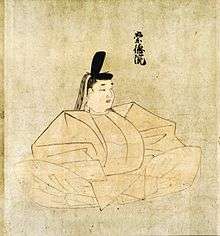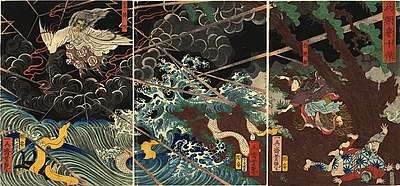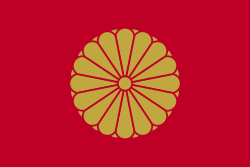Emperor Sutoku
Emperor Sutoku (崇徳天皇, Sutoku-tennō, July 7, 1119 – September 14, 1164) was the 75th emperor of Japan,[1] according to the traditional order of succession.[2]
| Sutoku | |
|---|---|
 | |
| Emperor of Japan | |
| Reign | February 25, 1123 – January 5, 1142 |
| Coronation | March 18, 1123 |
| Predecessor | Toba |
| Successor | Konoe |
| Born | July 7, 1119 |
| Died | September 14, 1164 (aged 45) |
| Burial | Shiramine no misasagi (Kagawa) |
| Spouse | Fujiwara no Kiyoko |
| Issue | Prince Shigehito |
| House | Yamato |
| Father | Emperor Toba |
| Mother | Fujiwara no Tamako |
Sutoku's reign spanned the years from 1123 through 1142.[3]
Genealogy
Before his ascension to the Chrysanthemum Throne, his personal name (his imina)[4] was Akihito (顕仁).[5]
- Note: Although the Roman alphabet-spelling of the name of this twelfth-century emperor is the same as that of the personal name of the Emperor Emeritus of Japan, the kanji are dissimilar.
- Emperor Sutoku, formerly Prince Akihito (顕仁)
- Emperor Emeritus, formerly Prince Akihito (明仁)
- Note: Although the Roman alphabet-spelling of the name of this twelfth-century emperor is the same as that of the personal name of the Emperor Emeritus of Japan, the kanji are dissimilar.
Sutoku was the eldest son of Emperor Toba. Some old texts say he was actually the son of Toba's grandfather, Emperor Shirakawa.
- Chūgū: Fujiwara no Kiyoko (藤原 聖子) later Kōkamon'in (皇嘉門院), Fujiwara Tadamichi’s daughter
- Hyounosuke-no-Tsubone (兵衛佐局), Minamoto Masamune's adopted daughter
- First son: Imperial Prince Shigehito (重仁親王) (1140–1162).
- Mikawa-dono (三河), Minamoto Morotsune's daughter
- Fifth Son: Kakue (覚恵; 1151-1184)
- Karasuma-no-Tsubone (烏丸局)
Events of Sutoku's life
- February 25, 1123 (Hōan 4, 28th day of the 1st month): In the 16th year of Emperor Toba's reign (鳥羽天皇二十五年), he abdicated; and the succession (‘‘senso’’) was received by his son, aged 3.[6]
- Hōan 4, in the 2nd month (1123): Emperor Sutoku is said to have acceded to the throne (‘‘sokui’’).[7]
- 1124 (Tenji 1, 2nd month): Former-Emperor Shirakawa and former-Emperor Toba went in carriages to outside the city where they could all together enjoy contemplating the flowers. Taiken-mon'in (? – August 26, 1145) (formerly Fujiwara no Shōshi), who was Toba's empress and Sutoku's mother, joined the procession along with many other women of the court. Their cortege was brilliant and colorful. A great many men of the court in hunting clothes followed the ladies in this parade. Fujiwara Tadamichi then followed in a carriage, accompanied by bands of musicians and women who were to sing for the emperors.[8]
- 1124 (Tenji 1, 10th month): Shirakawa visited Mount Kōya.[9]
- 1125 (Tenji 2, 10th month): The emperor visited Iwashimizu Shrine and the Kamo Shrines; and afterwards, he also visited the shrines Hirano, Ōharano, Mutsunoo, Kitano, Gion and several others.[9]
- 1128 (Daiji 3, 3rd month): Taiken-mon'in ordered the construction of Enshō-ji in fulfillment of a sacred vow.[10] This was one in a series of "sacred vow temples" (gogan-ji) built by imperial command following a precedent established by Emperor Shirakawa's Hosshō-ji.[11]
- 1128 (Daiji 3, 6th month): Fujiwara Tadamichi is relieved of his responsibilities and duties as sesshō (regent); and simultaneously, Tadamichi is named kampaku.[10]
- August 17, 1135 (Hōen 1, 7th day of the 7th month): Former-Emperor Shirakawa died at the age of 77.[12]
- 1141 (Eiji 1, 3rd month): The former emperor Toba accepted the tonsure in becoming a monk at the age of 39.[10]
In 1151, Sutoko ordered Waka imperial anthology Shika Wakashū.
In 1156, after failing to put down the Hōgen Rebellion, he was exiled to Sanuki Province (modern-day Kagawa prefecture on the island of Shikoku). Emperor Sutoku's reign lasted for 19 years: 2 years in the nengō Tenji, 5 years in Daiji, 1 year in 'Tenshō, 3 years in Chōshō, 6 years in Hōen, and 1 year in Eiji.[10]
The site of Sutoku's grave is settled.[1] This emperor is traditionally venerated at a memorial Shinto shrine (misasagi) in Sakaide, Kagawa.[13] He was also enshrined (or sealed away ... ) in Shiramine shrine (Shiramine-jingū), Kyoto and Kotohira-gū in Kagawa Prefecture. The former is also associated with the god of football, worshipped by Kuge clan Asukai in times of yore, while the latter enshrined Ō-mono-nushi-no-mikoto, a god known to have restored harmony in Yamato (or blackmailed Emperor Sujin ... ) in exchange for worship and nepotism.
The Imperial Household Agency designates this location as Sutoku's mausoleum. It is formally named Shiramine no misasagi.[14]
Kugyō
Kugyō (公卿) is a collective term for the very few most powerful men attached to the court of the Emperor of Japan in pre-Meiji eras.
In general, this elite group included only three to four men at a time. These were hereditary courtiers whose experience and background would have brought them to the pinnacle of a life's career. During Sutoku's reign, this apex of the Daijō-kan included:
Eras of Sutoku's reign
The years of Sutoku's reign are more specifically identified by more than one era name or nengō.[15]
Legends

After Sutoku's abdication and exile, he devoted himself to monastic life. He copied numerous scriptures and offered them to the court. Fearing that the scriptures were cursed, the court refused to accept them.[17] Snubbed, Sutoku was said to have resented the court and, upon his death, became an onryō. Everything from the subsequent fall in fortune of the Imperial court, the rise of the samurai powers, draughts and internal unrests were blamed on his haunting.
Along with Sugawara no Michizane and Taira no Masakado, he is often called one of the “Three Great Onryō of Japan.” (ja).[18]
Ancestry
| Ancestors of Emperor Sutoku | |||||||||||||||||||||||||||||||||||||||||||||||||||||||||||||||||||||||||||||||||||||||||||||||||||||||||||||||||||||||||||||||||||||||||||||||||||||||||||||||||||||||||||||||||||||||||||||||||||||||||||||||||||||||||||||||||||||||||||||||||||||||||||||||||||||||||||||||||||||||||||||||||||||||||||||||||||||||||||||||||||||||||||||||||||||||||||||||||||||||||||||||||||||||||||||||||||||||||||||||||||||||||||||||||||||||||||||||||||||||||||||||||||||||||||||||||||||||||||||||||||||||||||||||||||||||||||||||||||||||||||||||||||||||||||||
|---|---|---|---|---|---|---|---|---|---|---|---|---|---|---|---|---|---|---|---|---|---|---|---|---|---|---|---|---|---|---|---|---|---|---|---|---|---|---|---|---|---|---|---|---|---|---|---|---|---|---|---|---|---|---|---|---|---|---|---|---|---|---|---|---|---|---|---|---|---|---|---|---|---|---|---|---|---|---|---|---|---|---|---|---|---|---|---|---|---|---|---|---|---|---|---|---|---|---|---|---|---|---|---|---|---|---|---|---|---|---|---|---|---|---|---|---|---|---|---|---|---|---|---|---|---|---|---|---|---|---|---|---|---|---|---|---|---|---|---|---|---|---|---|---|---|---|---|---|---|---|---|---|---|---|---|---|---|---|---|---|---|---|---|---|---|---|---|---|---|---|---|---|---|---|---|---|---|---|---|---|---|---|---|---|---|---|---|---|---|---|---|---|---|---|---|---|---|---|---|---|---|---|---|---|---|---|---|---|---|---|---|---|---|---|---|---|---|---|---|---|---|---|---|---|---|---|---|---|---|---|---|---|---|---|---|---|---|---|---|---|---|---|---|---|---|---|---|---|---|---|---|---|---|---|---|---|---|---|---|---|---|---|---|---|---|---|---|---|---|---|---|---|---|---|---|---|---|---|---|---|---|---|---|---|---|---|---|---|---|---|---|---|---|---|---|---|---|---|---|---|---|---|---|---|---|---|---|---|---|---|---|---|---|---|---|---|---|---|---|---|---|---|---|---|---|---|---|---|---|---|---|---|---|---|---|---|---|---|---|---|---|---|---|---|---|---|---|---|---|---|---|---|---|---|---|---|---|---|---|---|---|---|---|---|---|---|---|---|---|---|---|---|---|---|---|---|---|---|---|---|---|---|---|---|---|---|---|---|---|---|---|---|---|---|---|---|---|---|---|---|---|---|---|---|---|---|---|---|---|---|---|---|---|---|---|---|---|---|---|---|---|---|---|---|---|---|---|---|---|---|---|---|---|---|---|---|---|---|---|---|---|---|---|---|---|---|---|---|---|---|---|---|---|---|---|---|---|---|---|---|---|---|---|---|---|---|---|---|---|---|---|---|---|---|---|---|---|---|---|---|---|---|---|---|---|---|---|---|---|---|---|---|---|---|---|---|---|---|---|---|---|---|---|---|---|---|---|---|---|---|---|---|---|---|---|---|---|---|---|---|---|---|---|---|---|---|---|---|---|---|---|---|---|---|---|---|---|---|---|---|---|
| |||||||||||||||||||||||||||||||||||||||||||||||||||||||||||||||||||||||||||||||||||||||||||||||||||||||||||||||||||||||||||||||||||||||||||||||||||||||||||||||||||||||||||||||||||||||||||||||||||||||||||||||||||||||||||||||||||||||||||||||||||||||||||||||||||||||||||||||||||||||||||||||||||||||||||||||||||||||||||||||||||||||||||||||||||||||||||||||||||||||||||||||||||||||||||||||||||||||||||||||||||||||||||||||||||||||||||||||||||||||||||||||||||||||||||||||||||||||||||||||||||||||||||||||||||||||||||||||||||||||||||||||||||||||||||||
See also
- Shin Heike Monogatari, (Taiga Drama), Masakazu Tamura played Emperor Sutoku.
- Emperor of Japan
- List of Emperors of Japan
- Imperial cult
Notes

- Imperial Household Agency (Kunaichō): 崇徳天皇 (75)
- Ponsonby-Fane, Richard. (1959). The Imperial House of Japan, pp. 80.
- Titsingh, Isaac. (1834). Annales des empereurs du japon, pp. 181-185; Brown, Delmer et al. (1979). Gukanshō, pp. 322–324; Varley, H. Paul. (1980). Jinnō Shōtōki. pp. 204–205.
- Brown, pp. 264. [Up until the time of Emperor Jomei, the personal names of the emperors (their imina) were very long and people did not generally use them. The number of characters in each name diminished after Jomei's reign.]
- Titsingh, p. 181; Brown, p. 322; Varley, p. 204.
- Brown, p. 322; Varley, p. 44. [A distinct act of senso is unrecognized prior to Emperor Tenji; and all sovereigns except Jitō, Yōzei, Go-Toba, and Fushimi have senso and sokui in the same year until the reign of Go-Murakami.]
- Titsingh, p. 182; Varley, p. 44.
- Titsingh, p. 182; Varley, p. 204.
- Titsingh, p. 182.
- Titsigh, p. 185.
- Varley, p. 200. (The six gogan-ji) "superiority" temples were: 1. Hosshō-ji (Superiority of Buddhist Law); 2. Sonshō-ji (Superiority of Worship); 3. Saishō-ji (Most Superior); 4. Enshō-ji (Superiority of Perfection); 5. Jōshō-ji (Superiority of Becoming); 6. Enshō-ji (Superiority of Duration).]
- Brown, p. 323.
- "崇徳上皇" (in Japanese). Sakaide city official. Retrieved 25 July 2019.
- Ponsonby-Fane, p. 419.
- Titsingh, pp. 181-185; Brown, p. 323.
- "Utagawa Yoshitsuya: Princess Shirinui Fights off the Evil Sotoku-in - The Art of Japan". ukiyo-e.org. Retrieved 18 April 2018.
- Ponsonby-Fane, Richard. (1963). Vicissitudes of Shinto, p. 99.
- 山田雄司 (2014). 妖怪とは何か 菅原道真・平将門・崇徳院. 中公新書. 中央公論新社. pp. i–iii頁. ISBN 978-4-12-102281-3.
- "Genealogy". Reichsarchiv (in Japanese). Retrieved 27 October 2018.
References
- Brown, Delmer M. and Ichirō Ishida, eds. (1979). Gukanshō: The Future and the Past. Berkeley: University of California Press. ISBN 978-0-520-03460-0; OCLC 251325323
- Ponsonby-Fane, Richard Arthur Brabazon. (1959). The Imperial House of Japan. Kyoto: Ponsonby Memorial Society. OCLC 194887
- _____________. (1963). Vicissitudes of Shinto. Kyoto: Ponsonby Memorial Society. OCLC 36655
- Titsingh, Isaac. (1834). Nihon Odai Ichiran; ou, Annales des empereurs du Japon. Paris: Royal Asiatic Society, Oriental Translation Fund of Great Britain and Ireland. OCLC 5850691
- Varley, H. Paul. (1980). Jinnō Shōtōki: A Chronicle of Gods and Sovereigns. New York: Columbia University Press. ISBN 978-0-231-04940-5; OCLC 59145842
| Regnal titles | ||
|---|---|---|
| Preceded by Emperor Toba |
Emperor of Japan: Sutoku 1123–1142 |
Succeeded by Emperor Konoe |
